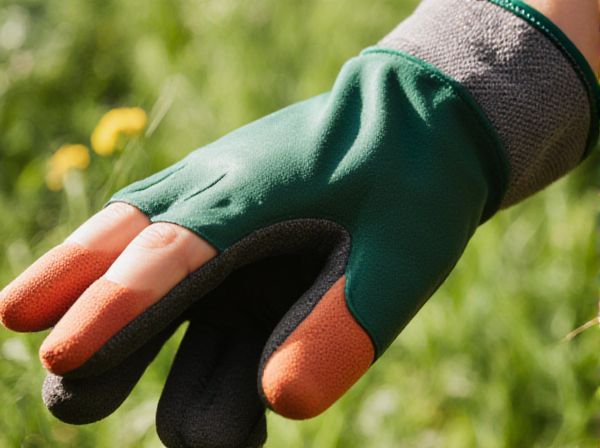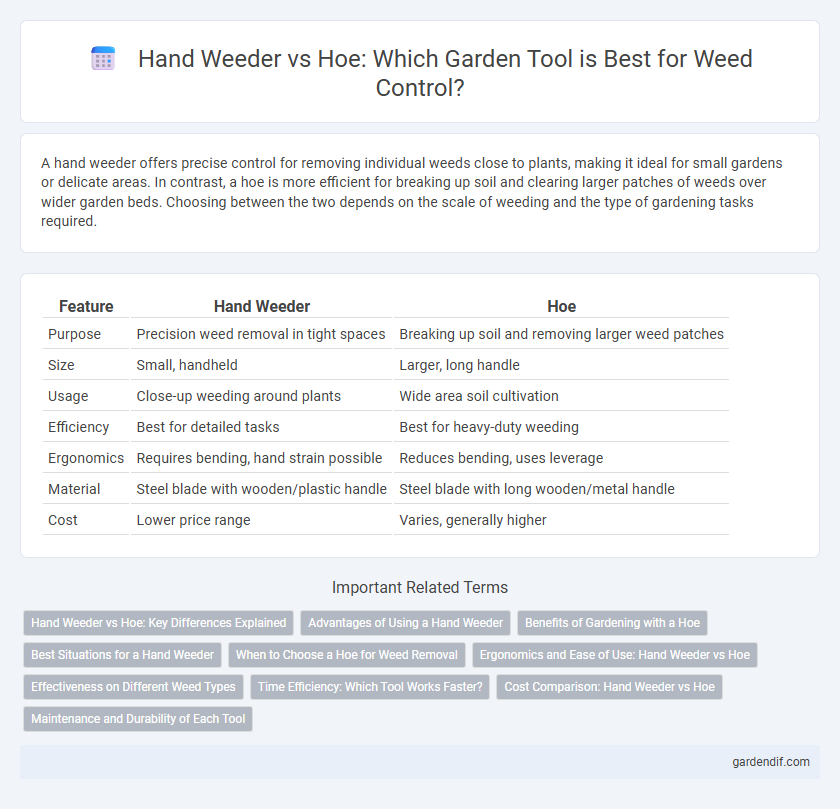
Hand Weeder vs Hoe Illustration
A hand weeder offers precise control for removing individual weeds close to plants, making it ideal for small gardens or delicate areas. In contrast, a hoe is more efficient for breaking up soil and clearing larger patches of weeds over wider garden beds. Choosing between the two depends on the scale of weeding and the type of gardening tasks required.
Table of Comparison
| Feature | Hand Weeder | Hoe |
|---|---|---|
| Purpose | Precision weed removal in tight spaces | Breaking up soil and removing larger weed patches |
| Size | Small, handheld | Larger, long handle |
| Usage | Close-up weeding around plants | Wide area soil cultivation |
| Efficiency | Best for detailed tasks | Best for heavy-duty weeding |
| Ergonomics | Requires bending, hand strain possible | Reduces bending, uses leverage |
| Material | Steel blade with wooden/plastic handle | Steel blade with long wooden/metal handle |
| Cost | Lower price range | Varies, generally higher |
Hand Weeder vs Hoe: Key Differences Explained
Hand weeders provide precise control for removing individual weeds by hand, making them ideal for small garden beds and delicate plants. Hoes cover larger areas efficiently, cutting weeds at the soil surface and disrupting root systems with less effort. Choosing between a hand weeder and a hoe depends on the scale of weeding needed and the type of vegetation being managed.
Advantages of Using a Hand Weeder
A hand weeder offers precise control for removing individual weeds without disturbing surrounding plants, making it ideal for garden beds and tight spaces. Its lightweight and ergonomic design reduces hand fatigue, allowing for extended use during weeding tasks. This tool also minimizes soil disruption, promoting healthier root systems and better soil structure compared to a hoe.
Benefits of Gardening with a Hoe
Gardening with a hoe enhances soil aeration and weed control by efficiently cutting through roots and loosening compacted soil, promoting healthier plant growth. Its broad blade allows for faster coverage of large garden areas compared to hand weeders, saving time and physical effort. Using a hoe also reduces the need for chemical herbicides, supporting organic gardening practices and sustainable soil management.
Best Situations for a Hand Weeder
Hand weeders excel in tight garden spaces and around delicate plants where precision is crucial to prevent root damage. They are ideal for removing individual weeds in flower beds, vegetable patches, and container gardens without disturbing surrounding soil. Their ergonomic design allows for extended use in small-scale weeding tasks requiring careful root removal.
When to Choose a Hoe for Weed Removal
Choose a hoe for weed removal when working on large, open garden beds where efficiency and speed are crucial. Hoes effectively uproot young weeds before they mature, making them ideal for early weed control in vegetable rows and flowerbeds. Their long handles reduce strain by allowing upright use, enabling the removal of weeds without bending over constantly.
Ergonomics and Ease of Use: Hand Weeder vs Hoe
Hand weeders offer superior ergonomics by allowing precise control and reducing strain through a lightweight, compact design suited for detailed weeding in tight spaces. Hoes provide leverage and cover larger areas quickly but may cause more fatigue due to repetitive motion and a heavier build. Choosing between the two depends on the balance between comfort during extended use and efficiency over broad garden beds.
Effectiveness on Different Weed Types
Hand weeders excel at removing individual, deep-rooted weeds like dandelions and thistles by targeting the root system with precision, minimizing soil disturbance. Hoes are more effective for controlling large areas of shallow-rooted weeds such as crabgrass and chickweed by cutting off weed growth near the surface quickly and efficiently. Choosing between a hand weeder and a hoe depends on the weed species, root depth, and area coverage for optimal weed management.
Time Efficiency: Which Tool Works Faster?
A hand weeder provides precision by targeting individual weeds, making it ideal for small garden beds but slower over large areas. A hoe efficiently clears larger patches of weeds quickly, significantly reducing labor time compared to hand weeding. For extensive weeding tasks, using a hoe increases time efficiency, whereas hand weeders excel in detailed, time-consuming weed removal.
Cost Comparison: Hand Weeder vs Hoe
Hand weeders typically cost between $5 and $15, making them an affordable option for small-scale gardening and precise weed removal. Hoes generally range from $10 to $30, reflecting their larger size and versatility for cultivating larger areas. Choosing between a hand weeder and a hoe depends on budget constraints and the scope of garden maintenance required.
Maintenance and Durability of Each Tool
Hand weeders require minimal maintenance, with occasional cleaning and sharpening to maintain effectiveness, while hoes demand more upkeep due to their larger size and increased wear from frequent soil contact. Durability of hand weeders typically stems from stainless steel or carbon steel blades and ergonomic handles, offering long-term performance with proper care. Hoes, often constructed with heavy-duty steel heads and sturdy wooden or fiberglass handles, provide robust durability but may need handle replacement or head tightening over time.
Hand Weeder vs Hoe Infographic

 gardendif.com
gardendif.com